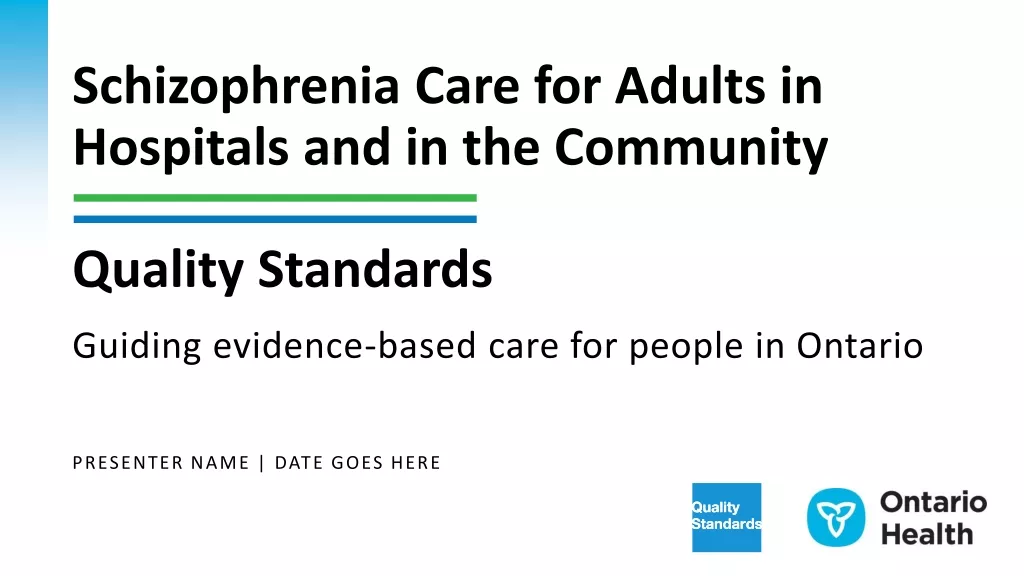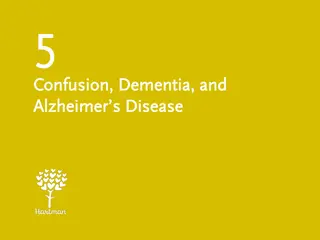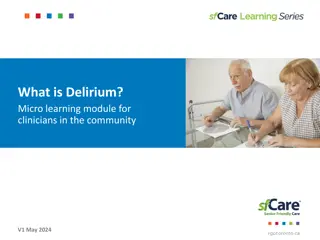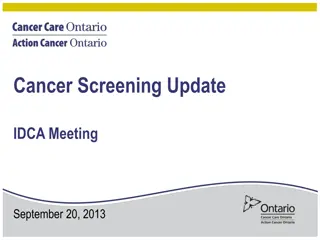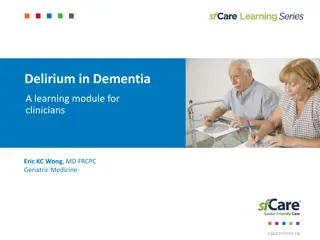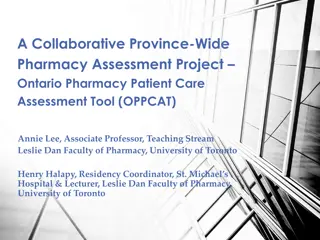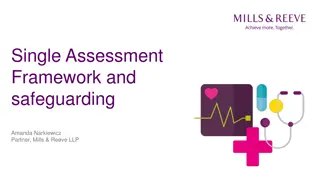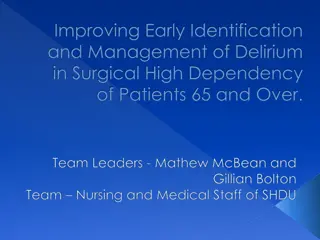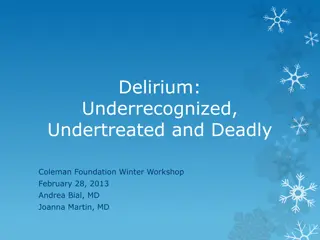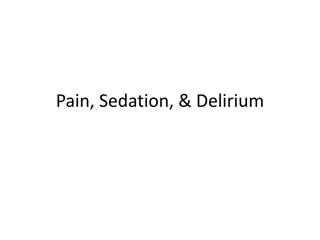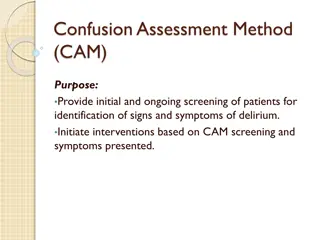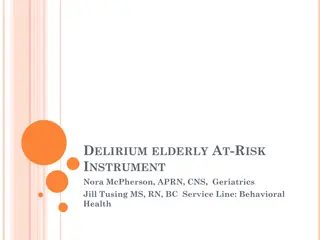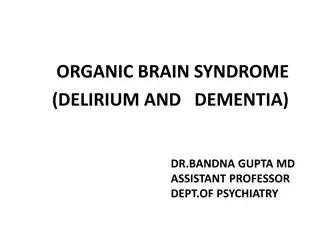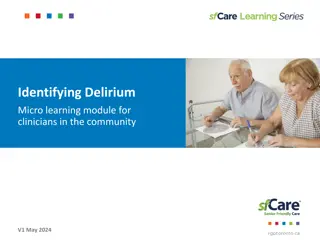Delirium Quality Standard in Ontario: Improving Evidence-Based Care
Delirium quality standards in Ontario aim to guide evidence-based care for adults by addressing gaps and variations in care quality. These standards inform clinicians, patients, and organizations on what quality care looks like, incorporating the best available evidence to ensure consistent, high-quality care across the province. Resources like patient guides and measurement tools support the implementation of these standards.
Download Presentation

Please find below an Image/Link to download the presentation.
The content on the website is provided AS IS for your information and personal use only. It may not be sold, licensed, or shared on other websites without obtaining consent from the author.If you encounter any issues during the download, it is possible that the publisher has removed the file from their server.
You are allowed to download the files provided on this website for personal or commercial use, subject to the condition that they are used lawfully. All files are the property of their respective owners.
The content on the website is provided AS IS for your information and personal use only. It may not be sold, licensed, or shared on other websites without obtaining consent from the author.
E N D
Presentation Transcript
Delirium Quality Standard Guiding evidence-based care for adults in Ontario
Objectives Overview of quality standards What are they? How are they used? Why this quality standard is needed Gaps and variations in quality of care for people with delirium in Ontario Quality statements to improve care The key statements in the delirium quality standard How to measure overall success Indicators that can help measure your quality improvement efforts 1
Quality Standards Inform clinicians and patients what quality care looks like Focus on conditions or processes where there are large variations in how care is delivered, or where there are gaps between the care provided in Ontario and the care patients should receive Are grounded in the best available evidence 2
Quality Standards Help health care professionals know what care to offer, based on evidence and expert consensus Help patients, residents, families, and caregivers know what to ask for in their care Help health care organizations measure, assess, and improve the quality of care they provide Help ensure consistent, high-quality care across the province 3
Quality Standard Resources Patient Guide Quality Standard Getting Started Guide Measurement Guide Placemat 4 Find these resources here: https://www.hqontario.ca/evidence-to-improve-care/quality-standards/view-all-quality-standards/delirium
Inside the Quality Standard The Audience Statements The Quality Statement The Definitions The Indicators 5
Quality Standards: Patient Guide The patient guide is designed to give patients information about what quality care looks like for various conditions based on the best evidence, so they can ask informed questions of their health care providers. 6
Quality Standards: How the Health Care System Can Support Implementation Implementing quality standards can be challenging due to system-level barriers or gaps, many of which have been identified throughout the development of this standard. Ontario Health will work with and support other provincial partners, including the Ministry of Health, to bridge system- level gaps to support the implementation of quality standards. 7
Quality Standards: Implementation Tools The Getting Started Guide: Outlines the process for using the quality standard as a resource to deliver high-quality care Contains evidence-based approaches, as well as useful tools and templates for implementing change ideas at the practice level 8
Quality Standard Adoption Tools: QUORUM Quorum is an online community dedicated to improving the quality of health care in Ontario. The Quality Standards Adoption Series highlights efforts in the field to implement changes and close gaps in care related to quality standard topics. 9 quorum.hqontario.ca
Quality Standards: Measurement Guide The measurement guide has two dedicated sections: Local measurement: what you can do to assess the quality of care that you provide locally Provincial measurement: how we can measure the success of the quality standard on a provincial level 10
Why Do We Need a Quality Standard for Delirium? 11
What Is Delirium? Delirium is an acute disorder of attention, awareness, and altered mental status.1 It develops over a short period of time (usually hours to a few days) and tends to fluctuate in severity during the course of a day.1 Other key clinical features of delirium include disorganized thinking, altered level of consciousness, disorientation, memory impairment, perceptual disturbances (illusions or hallucinations) and delusions, increased or decreased psychomotor activity, and disturbance of the sleep wake cycle.2 Sources: 1American Psychiatric Association. Diagnostic and statistical manual of mental disorders. 5th ed. Arlington (VA): The Association; 2013. 2Inouye SK, van Dyck CH, Alessi CA, Balkin S, Siegal AP, Horwitz RI. Clarifying confusion: the confusion assessment method. A new method for detection of delirium. Ann Intern Med. 1990;113(12):941-8. 12
Who Is at Risk for Delirium? Key risk factors for delirium include1,2: Age 65 years or older Cognitive impairment and/or dementia Current hip fracture (broken hip) Severe illness (a clinical condition that is deteriorating or is at risk for deterioration) Previous delirium Problematic alcohol or substance use Sources: 1National Institute for Health and Care Excellence. Delirium: prevention, diagnosis and management [Internet]. London (UK): The Institute; 2019 [cited 2019 Aug]. Available from: https://www.nice.org.uk/guidance/cg103 2Registered Nurses Association of Ontario. Delirium, dementia, and depression in older adults: assessment and care [Internet]. Toronto (ON): The Association; 2016 [cited 2019 Aug]. Available from: https://rnao.ca/sites/rnao- ca/files/bpg/RNAO_Delirium_Dementia_Depression_Older_Adults_Assessment_and_Care.pdf 13
Delirium is very common in older people in the hospital setting, with overall occurrence rates ranging from 29% to 64%.1 Settings with the highest incidence rates1,2 Setting Incidence Rates Palliative care 42% to 88% Intensive care 19% to 82% Post-surgical care 11% to 51% Long-term care or post-acute care 20% to 22% Prevalence in the community is lower (1% to 2%) but usually requires emergency care.1 Older people who present to emergency department 8% to 17% Sources: 1Inouye SK, Westendorp RG, Saczynski JS. Delirium in elderly people. Lancet. 2014;383(9920):911-22. 2Watt CL, Momoli F, Ansari MT, Sikora L, Bush SH, Hosie A, et al. The incidence and prevalence of delirium across palliative care settings: a systematic review. Palliat Med. 2019;33(8):865-77. 14
Delirium has been identified as the third most common harmful event experienced by people admitted to Canadian hospitals.1 It has also been associated with: Increased mortality across settings2 Increased hospital stay2 Increased placement in long- term care after hospitalization2 Sources: 1Chan B, Cochrane D. Measuring patient harm in Canadian hospitals. What can be done to improve patient safety? Ottawa (ON): Canadian Institute for Health Information, Canadian Patient Safety Institute; 2016. 2Inouye SK, Westendorp RG, Saczynski JS. Delirium in elderly people. Lancet. 2014;383(9920):911-22. 15
Delirium is often unrecognized, misdiagnosed as another disorder, or misattributed to dementia.1 It is recognized in only one-third of cases.2 However, early identification of risk factors is important because delirium can be prevented in 30% to 40% of cases.3 Sources: 1Inouye SK, van Dyck CH, Alessi CA, Balkin S, Siegal AP, Horwitz RI. Clarifying confusion: the confusion assessment method. A new method for detection of delirium. Ann Intern Med. 1990;113(12):941-8. 16 2Oh ES, Fong TG, Hshieh TT, Inouye SK. Delirium in older persons: advances in diagnosis and treatment. J Am Med Assoc. 2017;318(12):1161-74. 3Inouye SK, Westendorp RG, Saczynski JS. Delirium in elderly people. Lancet. 2014;383(9920):911-22.
In 2014, 92% of participating Ontario hospitals (n = 135) reported delirium screening and detection processes, an increase from 62% in 2011. Source:Wong K, Tsang A, Liu B. Update on senior friendly hospital care in Ontario [Internet]. Toronto (ON): Regional Geriatric Program of Toronto; 2015 [updated 2018; cited 2018 Jul 24]. Reproduced with permission from: https://www.rgptoronto.ca/wp- content/uploads/2017/12/SFH_Care_in_Ontario_2015.pdf 17
In 2014, 88% of participating Ontario hospitals (n = 135) reported delirium prevention and management procedures, an increase from 62% in 2011. Source:Wong K, Tsang A, Liu B. Update on senior friendly hospital care in Ontario [Internet]. Toronto (ON): Regional Geriatric Program of Toronto; 2015 [updated 2018; cited 2018 Jul 24]. Reproduced with permission from: https://www.rgptoronto.ca/wp- content/uploads/2017/12/SFH_Care_in_Ontario_2015.pdf 18
In 2014, 86% of participating Ontario hospitals (n = 135) reported monitoring and evaluating delirium practices, an increase from 34% in 2011. Source: Wong K, Tsang A, Liu B. Update on senior friendly hospital care in Ontario [Internet]. Toronto (ON): Regional Geriatric Program of Toronto; 2015 [updated 2018; cited 2018 Jul 24]. Reproduced with permission from: https://www.rgptoronto.ca/wp- content/uploads/2017/12/SFH_Care_in_Ontario_2015.pdf 19
There was a 47% increase in the number of inpatient admissions with documented delirium between 2014/15 and 2019/20. In 2019/20, 8% of all hospital admissions among people aged 65 and over included documented delirium. Number of people admitted to hospital for delirium and total number of hospital admissions for delirium, Ontario, 2014/15 to 2019/20 Percentage of hospital admissions among people aged 65 and over that included documented delirium, Ontario, 2014/15 to 2019 50,000 8% 8% 7% 7% 42,095 40,079 7% 38,387 40,000 37,358 35,747 6% 35,432 6% 34,364 6% 31,801 31,192 28,651 28,195 30,000 26,042 4% 20,000 2% 10,000 0 0% 2014/15 2015/16 2016/17 2017/18 2018/19 2019/20 Patients Admissions Percentage 20 Source: Discharge Abstract Database 2014/15 2019/20, Ontario Ministry of Health and Long-Term Care, IntelliHealth Ontario.
In 2019/20, in 49% of all hospital admissions with documented delirium, delirium presented prior to admission, whereas in 27%, delirium presented after admission or as a complication of admission. Percentage of hospital admissions with documented delirium by type of diagnosis, 2019/20 3% 20% Pre-Admit Comorbidity Post-Admit Comorbidity/Complication 49% Most Responsible Diagnosis Admitting Diagnosis 27% 21 Source: Discharge Abstract Database 2019/20, Ontario Ministry of Health and Long-Term Care, IntelliHEALTH ONTARIO
In 2019/20, the rate of people with documented delirium during their hospital stay was highest in the North East and Erie St. Clair regions and lowest in the North West and Waterloo Wellington regions. Rate (per 100,000) of people with documented delirium during their hospital stay, by region, in Ontario, 2017/18 to 2019/20 350.00 309.39 302.90 300.00 285.24 284.30 283.46 273.29 268.98 256.82 240.90 250.00 235.90 230.71 215.63 215.33 207.31 200.00 150.00 100.00 50.00 0.00 Erie St. Clair South West Waterloo Welligton Hamilton Niagara Haldimand Brant Central West Mississauga Toronto Central Central Central East South East Champlain North Simcoe North East North West Halton Muskoka 2017/18 2018/19 2019/20 Source: Discharge Abstract Database 2017/18 to 2019/20, Ontario Ministry of Health and Long-Term Care, IntelliHealth Ontario. StatisticsCanada estimates of population (2016 census and administrative data), by age group and sex for July 1, Canada, provinces, territories, health regions (2018 boundaries) and peer groups. Table 17-10-0134-01. 22
My husband was discharged home after a week in the ICU, and he soon became very disoriented and agitated, with some periods of lucidity. It was extremely frightening for both of us, and I wasn t sure how to help him. We eventually found out that he was very dehydrated, which led to his symptoms of delirium. When he was discharged, he was still quite frail, and we didn t receive any information on strategies for delirium prevention, which I m sure would have helped both of us. With this experience, I can see how the Delirium quality standard would be very helpful. All of the statements are interrelated and are important to guide patient care. My biggest hope is that the quality standard is applied in everyday practice to support patients, families, and caregivers in whichever setting or region across Ontario they are from. Education and preparedness are extremely valuable for patients and caregivers. Nicole Lafreni re-Davis, Lived Experience Advisor, Delirium Quality Standard Advisory Committee 23
As a nurse practitioner in geriatrics, I have seen many patients who developed delirium in the emergency department and on the wards. Delirium often goes undetected and can lead to significant challenges and harms for the patient and their families as well as for their health care providers. The quality standard on delirium is important because it raises the status of delirium as a clinical entity, and gives providers a standardized, logical approach to care with key metrics and indicators to track. Reinforcing the importance of this condition will also help to educate and empower families and caregivers. Mary-Lynn Peters, Delirium Quality Standard Advisory Committee 24
Quality Statements to Improve Care 25
Scopeof This Quality Standard This quality standard addresses care for adults aged 18 years or older who are at risk for delirium or who are experiencing symptoms of delirium. It includes people who are in hospital (including those in emergency departments, acute and critical care, complex continuing care and rehabilitation, and preoperative clinics), those transitioning from hospital to home, and those in long-term care homes and other home and community settings. The quality standard focuses on the identification, assessment, prevention, and management of delirium across all health care professions. Some of the statements in this standard may apply to people who develop delirium at end of life one of many common symptoms associated with a progressive, life-limiting illness. This quality standard does not apply to people with confusion related to withdrawal from alcohol. It also excludes guidance on the management of specific health complications secondary to delirium (e.g., falls, immobility, pressure injuries). 26
Quality Statement Topics 1. Identification of Risk Factors for Delirium 2. Interventions to Prevent Delirium 3. Early Screening for Delirium 4. Education for People With Delirium, Family, and Caregivers 5. Management of Delirium 6. Antipsychotic Medication 7. Transitions in Care 27
Quality Statement 1: Identification of Risk Factors for Delirium On initial contact with the health care system, people are assessed for risk factors for delirium, especially when they present to hospital or long-term care. Any risk factors for delirium are documented in their health record and at transitions in care, and are communicated to the person, their family and caregivers, and their health care team. 28
Quality Statement 2: Interventions to Prevent Delirium People at risk for delirium receive interventions to prevent delirium that are tailored to their individual needs and care setting. 29
Quality Statement 3: Early Screening for Delirium People presenting to hospital with any risk factors for delirium, or who have an acute change in behaviour or cognitive function during a hospital stay or in a long- term care home or in the community, are screened for delirium in a timely manner by a health care professional who is trained in screening for delirium using standardized, validated tools. The person and their family and caregivers are asked about any acute changes in the person s behaviour or cognitive function. 30
Quality Statement 4: Education for People With Delirium, Family, and Caregivers People who are at risk for delirium or who have delirium (as well as their family and caregivers) are offered education about delirium. 31
Quality Statement 5: Management of Delirium Based on the results of a comprehensive assessment, people with delirium have a multicomponent interprofessional management plan to address the causes and manage the symptoms of delirium. 32
Quality Statement 6: Antipsychotic Medication Only people who are in severe distress from symptoms of delirium or at immediate risk of harm to themselves or others are considered for antipsychotic medication use. These medications are always be used in combination with first-line management strategies. If antipsychotic medication is started, it is reviewed daily and discontinued as soon as the clinical situation allows. 33
Quality Statement 7: Transitions in Care At transitions in care, people with current or resolved delirium (as well as their family and caregivers) are given information related to delirium and its management. This information is communicated to those involved in the person s circle of care and documented in the health record at transitions in care. 34
How to Measure Overall Success 35
Indicators That Can Be Measured Using Provincial Data Rate of delirium among people admitted to hospital, with onset during their stay Percentage of people with delirium who are discharged from hospital to home and who report feeling that they were involved in care delivery and discharge planning as much as they wanted to be 36
Indicators That Can Be Measured Using Only Local Data Percentage of people at risk for delirium who have interventions to prevent delirium documented in their care plan Percentage of people with delirium who have a multicomponent interprofessional management plan to address the causes and manage the symptoms of delirium 37
Thank you. L E T S C O N T I N U E T H E C O N V E R S AT I O N HQOntario.ca | OntarioHealth.ca @OntarioHealthOH Ontario Health @OntarioHealthOH Ontario Health


